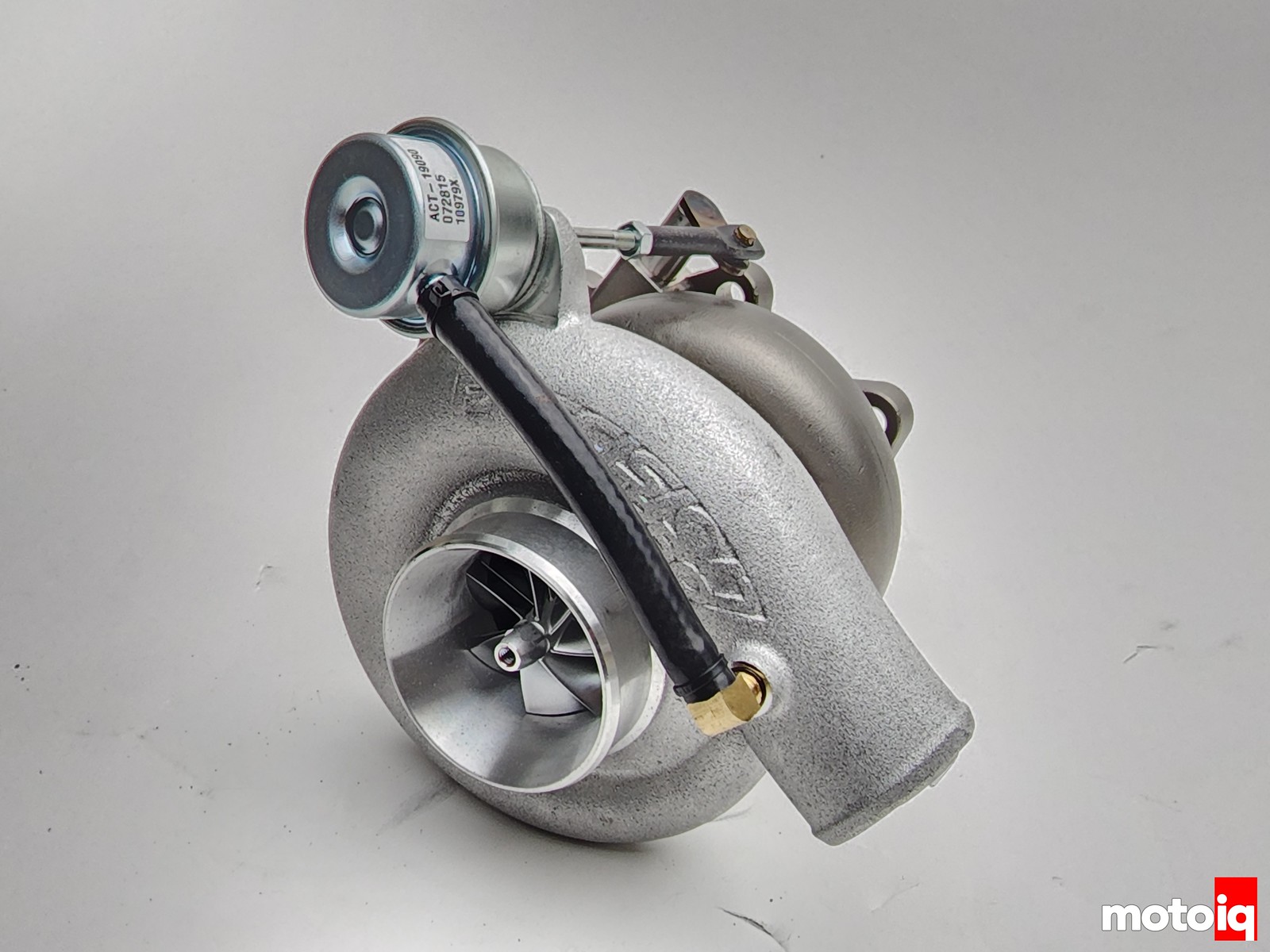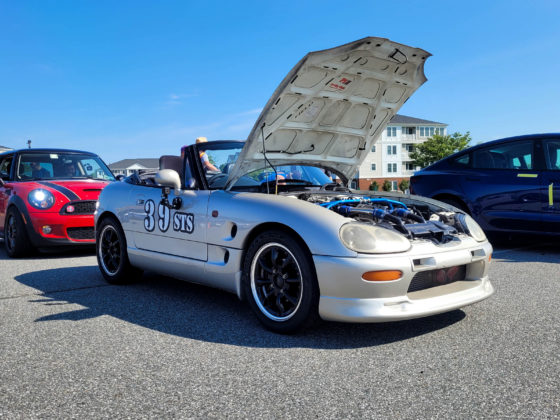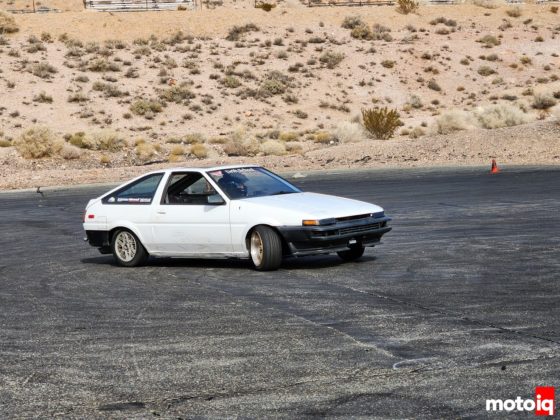
IHI does not use A/R as the turbine housing size spec but uses a measurement that they call the nozzle area. The stock nozzle area is 7 cm squared and some upgraded IHI turbos use a 10.5 cm squared housing. The stock turbo has an estimated A/R of around 0.60. We did some rough measurements and the Precision Turbo seems to have an A/R of about 0.75-0.80 depending on how thick the casting is. These measurements are totally appropriate for an engine like the EJ257. In this picture, you can see how much bigger and better flowing the Precision exhaust housing is internally over the IHI turbo. Having bespoke housings designed around the compressor and turbine wheels is a huge advantage over simply carving out the stock or slightly larger OEM housings for bigger wheels like most of the competition’s standard position Subaru turbo upgrades.

As you can see here, the Precision turbos stainless steel parts are going to look a lot better after time than the rusty OEM cast iron parts. The turbo comes with all the parts to make the installation a total bolt-in.

Previously we were using Injector Dynamics 1300 cc/min injectors. However, in our previous tuning sessions, our injectors were running at over 90% of their duty cycle on E85 so we needed bigger injectors so we turned to Injector Dynamics once again for a set of 1700cc/min injectors.
Injector Dynamics starts with brand new Bosch EV14 injectors which are matched in batched sets using Injector Dynamics measuring benches and methodology. First, new injectors are dynamically broken in on a bench for about an hour. Injector Dynamics has found that it takes about this long for new injectors to settle down and produce consistent flow results. The injectors are then flowed through their dynamic range using the proper fuel pressure and using fuel as the test fluid, not a test solvent. The temperatures are carefully controlled during the test for consistent results. After break-in and flowing the injectors are sorted into matched sets. Within each set, the dynamic flow rate (slope) will vary no more than +/- 1%, and the dead time (offset) will vary no more than +/- 20 microseconds which is equivalent to +/- 1% at a pulsewidth of 2 milliseconds. To our knowledge, only Injector Dynamics offers complete operating range matched injector sets.
So we don’t want a whole lot, Just to get our engine’s cam, porting and turbo all to match up a little better and give more area under the power curve. Our engine already has pretty refined power characteristics but we feel that it can get even better. Our Project STI is a really refined giant killer that achieves our goal of being engineered like a factory special model. Stay tuned, we are next going to be doing more driveability and power tuning and will report on the results.




13 comments
Great artilce, but it would be helpful fo provide id’sfor the 3 different curves for the two dyno runs. The legend on the left side of the graph was clipped of in the window. Based on text, the left side was @ 25 psi, and 17 on the right ?
Good Garret article on A/R’s, with differences shown on track performance.
https://www.garrettmotion.com/news/newsroom/article/turbo-tech-how-to-turbo-and-the-difference-an-a-r-makes-for-optimizing-your-turbo-system/
The traces on the dyno chart are 25 psi, 17 psi, and a full bolt-on VA STI. The point was that the power falls as the IAT climbs drastically. Conversely, on our time attack cars, we have been going to smaller turbos and A/R and turning faster lap times even with sometimes hundreds less HP. For instance, the ENEOS 86 went from around 1000 whp to 750 and we went many seconds a lap faster due to better driveability and not being so solid on the traction control. Most of the time in Time Attack mid range helps quite a bit for reducing lap times.
Thanks for the reply Mike. Your faster TimeAttack laps with the smaller upgraded turbo & A/R are similar to how a smaller A/R turbo was better for circuits with more corners, and the larger A/R was better at fast tracks, as discussed in the Garret link I provided.
But my question about the Dyno runs was related to the 3 pulls for each boost pressure. I figure the segmented green curve is stock, the dark maroon is 1st upgrade, and the light maroon the bigger Precision Turbo upgrade.
“The traces on the dyno chart are 25 psi, 17 psi, and a full bolt-on VA STI.”
I get it. I should have looked at the graphs more carefully.
I should have explained it better.
Can’t wait to see the results! Thanks for being so transparent with all the teething problems. I can’t imagine the dyno bills being too pleasant on your wallet, but even if money is no object, Church must have a looong wait list as well.
The results we currently have are decent, we are just looking to optimize things and make them efficient as possible.
What size injectors are you moving up to? I’m excited to see this turbo do work. The results from that 55mm version are impressive.
Thank you for pointing out that I stupidly forgot to put the injector size in the story, I edited that! They are 1700cc/min.
All good. I just got my IAG-700 block installed, so I don’t have the same long rod setup you have. I’m thinking that the ID1300’s and precision turbo setup you’re currently rocking is about the right setup for my car. I’ve got a lot of the same mods with a dual radium hanger, single W450, XClutch twin disk, etc. I need to replace my ID1050x’s with some ID1300’s and grab a delicious tuning flex kit. To say I’m watching this build closely is an understatement.
A lot of those decisions were made based on these stories. Appreciate all of the work you put into this. Hopefully the word gets back to your suppliers so they know that your publication works. 🙂
I am currently running at 95% duty cycle on E85 so maybe you might want to consider the bigger injectors. They just run something like 13:1 at idle to get a decent idle. The 1300’s idle at about 13.5:1. The X disc is awesome, once it breaks in, it’s nearly as smooth as stock. Before settling on a fuel pump check out what iWire says about a big single. I would have probably done a brushless pump but there was none of the right size available when I was piecing things out. Deatchwerks just came out with some cool smaller brushless offerings.
Hi Mike,
Any updates on latest Dyno / test results ?
Did it resolve the issue up the top end ?
Looking at the same turbo for a high revving built EJ207.
Cheers
Starting to work on the car again now. It’s sort of an aversion to tearing into a wonderfully running car, hahaha.